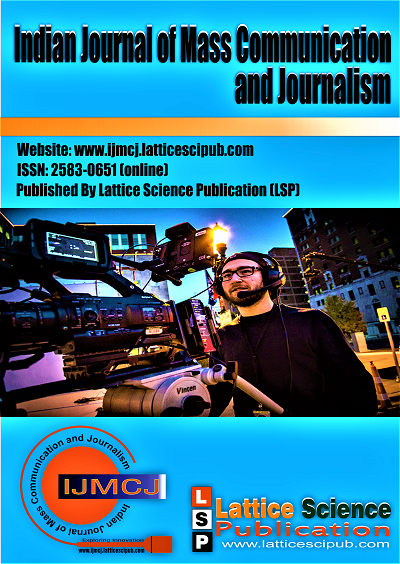Conceptual Blending in Indian Political Cartoon Discourse
Main Article Content
Abstract
Conceptual blending theory has been used by scholars to study various genres of texts. Scholars studying cartoons in particular have used it to study how metaphors and metaphorical blending are used in cartoons to construct meaningful texts. This paper studies selected Indian political cartoons using the Conceptual Blending Theory of Fauconnier and Turner. The themes of the cartoons chosen for the study focused on various social issues that were part of themedia discourse in contemporary times. The study was conducted to understand how cartoons depicting social issues used metaphoric blending to visualise an issue. The paper found that the graphic form of the political cartoon mediates the understanding of a communicative event through the use of cognitive devices like metaphoric blends. It was found that novel metaphoric blends were created in a cartoon text depending on the nature of the issue and that these metaphorical blends are regulated by context and background knowledge regarding the event being represented. It was also observed that the novelty of metaphoric blends in Indian editorial cartoons depended on the social, political and cultural context. Meanwhile, the metaphoric blends also draw into it everyday objects and scenarios that structure the meaning potential of the political cartoon. Another relevant finding is regarding how certain cartoon texts had more than one conceptual blend, forming a network of blends that worked in conjunction with each other. Furthermore, it was observed how conceptual blends in cartoons aided in anchoring the meaning of the cartoon and prevented polysemic confusion. The findings of the research prove that cognitive devices are prevalent in cartoon texts and could significantly direct their interpretation and use.
Downloads
Article Details

This work is licensed under a Creative Commons Attribution-NonCommercial-NoDerivatives 4.0 International License.
How to Cite
References
Chen, K. W., Phiddian, R., & Stewart, R. (2017). Towards a discipline
of political cartoon studies: mapping the field. In Springer eBooks (pp.
–162). https://doi.org/10.1007/978-3-319-56774-7_5
El Refaie, E. (2009b). Multiliteracies: how readers interpret political
cartoons. Visual Communication, 8(2), 181–205.
https://doi.org/10.1177/1470357209102113
Forceville, C. (2009). Chapter 2. Non-verbal and multimodal
metaphor in a cognitivist framework: Agendas for research. In De
Gruyter eBooks (pp. 19–44).
https://doi.org/10.1515/9783110215366.1.19
Abdel-Raheem, A. (2021). Multimodal metaphor and (im)politeness
in political cartoons: A sociocognitive approach. Journal of
Pragmatics, 185, 54–72.
https://doi.org/10.1016/j.pragma.2021.08.006
Bounegru, L., & Forceville, C. (2011b). Metaphors in editorial
cartoons representing the global financial crisis. Visual
Communication, 10(2), 209–229.
https://doi.org/10.1177/1470357211398446
Van Dijk, T. A. (2014). Discourse and Knowledge: A Sociocognitive
approach. http://ebooks.cambridge.org/ref/id/CBO9781107775404
Pavlović, V. (2010). Newspaper Cartoons Related to the Current
Serbian Political Scene from the Perspective of the Conceptual
Blending Theory. Social Science Research Network.
https://papers.ssrn.com/sol3/Delivery.cfm/SSRN_ID2464244_code1
pdf?abstractid=2464244&mirid=5
Marin-Arrese, J. I. (2008b). Cognition and culture in political
cartoons. Intercultural Pragmatics, 5(1), 1–18.
https://doi.org/10.1515/ip.2008.001
Rohrer, T. (2004). Race-baiting, Cartooning and Ideology: A
conceptual blending analysis of contemporary and WW II war
cartoons. In Deutscher Universitätsverlag eBooks (pp. 193–215).
https://doi.org/10.1007/978-3-322-81345-9_12
Fauconnier, G., & Turner, M. (1998). Conceptual integration
networks. Cognitive Science, 22(2), 133–187.
https://doi.org/10.1016/s0364-0213(99)80038-x
Lakoff, G., & Johnson, M. (1980). Metaphors we live by.
http://www.berliner.dk/mediesnak/opgaver/lj_noter.pdf
Fauconnier, G., & Turner, M. (2002). The way we think: conceptual
blending and the mind’s hidden complexities. Choice Reviews Online,
(02), 40–1223. https://doi.org/10.5860/choice.40-1223
Lefebvre, H. (1991). Critique of everyday life.
http://www.gbv.de/dms/mpib-toc/637644050.pdf
Coulson, S. (2006). Conceptual blending in thought, rhetoric, and
ideology. In De Gruyter eBooks (pp. 187–210).
https://doi.org/10.1515/9783110197761.2.187
Coulson, S., & Oakley, T. (2001). Blending basics. Cognitive
Linguistics, 11(3–4), 175–196. https://doi.org/10.1515/cogl.2001.014
Forceville, C. (2009). Chapter 2. Non-verbal and multimodal
metaphor in a cognitivist framework: Agendas for research. In De
Gruyter eBooks (pp. 19–44).
https://doi.org/10.1515/9783110215366.1.19
Kress, G., & Van Leeuwen, T. (2001). Multimodal Discourse: The
Modes and Media of Contemporary Communication.
http://discovery.ucl.ac.uk/10014912/
Valkenburg, P. M., Peter, J., & Walther, J. B. (2016). Media Effects:
Theory and research. Annual Review of Psychology, 67(1), 315–338.
https://doi.org/10.1146/annurev-psych-122414-033608
Henri Lefebvre: The Production of Space. (2008). In SAGE
Publications Ltd eBooks (pp. 60–97).
https://doi.org/10.4135/9781446215784.n3
Russell, B. (1912). The Problems of Philosophy.
http://emilkirkegaard.dk/en/wp-content/uploads/Bertrand-RussellThe-Problems-of-Philosophy1.pdf
Abysova, M. A., & Antipova, O. P. (2019). Political Ideologies
Language from the Perspective of Modern Western Society. In
International Journal of Innovative Technology and Exploring
Engineering (Vol. 9, Issue 1, pp. 2662–2668).
https://doi.org/10.35940/ijitee.l3395.119119
Hasan, Dr. S. B. (2022). Ala-ul Mulk: A Political Genius and
Confidant of Alauddin Khalji. In Indian Journal of Social Science and
Literature (Vol. 1, Issue 3, pp. 5–8).
https://doi.org/10.54105/ijssl.c1054.031322
21. Praveenadevi, Dr. D., & Girimurugan, Dr. B. (2019). Inclusive
Organisational Culture – A Competing Strategy for Business Success.
In International Journal of Recent Technology and Engineering
(IJRTE) (Vol. 8, Issue 4, pp. 5155–5159).
https://doi.org/10.35940/ijrte.d7371.118419
Srai, Dr. A., Guerouate, Prof. F., & Lahsini, Prof. H. D. (2021). The
Integration of the MDA Approach in Document-Oriented NoSQL
Databases, the case of Mongo DB. In International Journal of
Engineering and Advanced Technology (Vol. 10, Issue 3, pp. 115–
. https://doi.org/10.35940/ijeat.c2235.0210321
23. Islam, M., Mohamed, S. F., Mahmud, S. H., M, A. K. A., & Saeed,
K. A. (2020). Towards A Framework for Development of Operational
and Maintenance Cost Model of Highway Project in Malaysia. In
International Journal of Management and Humanities (Vol. 4, Issue 5,
pp. 89–95). https://doi.org/10.35940/ijmh.e0530.014520





